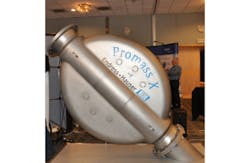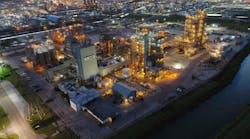Coriolis flowmeters are named after the French mathematician Gustave Coriolis. In 1835, Coriolis showed that an inertial force must be taken into account when describing the motion of bodies in a rotating frame of reference. The earth is commonly used as an example of this Coriolis force. Because the earth is rotating, an object thrown from the North or South Pole towards the equator will appear to deviate from its intended path.
Coriolis flowmeters are composed of one or more vibrating tubes, usually bent. The fluid to be measured passes through the vibrating tubes. The fluid accelerates as it passes towards the point of maximum vibration and decelerates as it leaves this point. The result is a twisting motion in the tubes. The degree of twisting motion is directly proportional to the fluid’s mass flow.
Coriolis flowmeters were introduced to the market in 1977 by Micro Motion. Since that time, over 20 companies have come to manufacture Coriolis flowmeters. One of the most significant events in the history of Coriolis meters occurred in 1994 when KROHNE introduced the first commercially successful straight-tube Coriolis meter. Straight-tube meters are less bulky than bent-tube meters. They have advantages for sanitary applications because the fluid doesn’t build up around the bends and curve of the meter. While straight-tube Coriolis meters have been quite successful for liquids, developing them for gas has proved to be a very challenging application.
READ ALSO: Coriolis Flowmeters for Gas Measurement—Advanced features serve the needs of a complex measurement
More than any other meter, Coriolis meters have line size limitations. Due to the nature of the technology, Coriolis meters get large and unwieldy once they reach the 4” size. Even 2” and 3” meters are quite large. Over two-thirds of Coriolis meters are for line sizes of 2” or less.
Companies that have introduced Coriolis flowmeters for line sizes above 6” include Rheonik (now part of GE Measurement), Endress+Hauser, KROHNE, and Micro Motion. Rheonik, Endress+Hauser, and Micro Motion mainly have bent-tube meters, while KROHNE’s large size meters are straight tube. There is definitely a trend among Coriolis suppliers towards offering flowmeters for the larger line sizes. Currently Coriolis meters are available in 8-, 10-, 12-, and 14” line sizes. Endress+Hauser has even introduced a meter that will accommodate line sizes of 16”.
All indications are that large line size meters are selling quite well. Why are they doing so well, considering that their price tags are generally greater than $50,000? The answer has to do with the enhanced value of the fluids they are measuring. Many of these meters are designed to go into the oil & gas industry. With oil selling at between $90 and $100 a barrel, the enhanced accuracy provided by Coriolis flowmeters can make a significant difference in the measurement of high-priced fluids. Coriolis meters also offer high reliability and minimal maintenance, so their cost of ownership is less than other meters despite their high initial cost. Look for more large line size Coriolis flowmeters to be released as suppliers continue to do R&D.
How will the larger size meters grow? One way is exemplified by Rheonik. Rheonik has put together two 6” Coriolis meters to create a meter that can handle larger line sizes. While it has sold a limited number of these meters, it does represent an interesting and creative way to deal with the line size issue. Perhaps lighter materials or other technological advances will make it possible to create more manageable Coriolis meters with large diameters. A similar innovation was used in making straight-tube meters; most straight tube meters are made from titanium. Any progress in this area is likely to be welcomed by customers who would like to have smaller and more compact Coriolis flowmeters in diameters above 2”.
Jesse Yoder, Ph.D., is president of Flow Research Inc. in Wakefield, Mass., a company he founded in 1998. He has 25 years of experience as an analyst and writer in process control. Dr. Yoder specializes in flowmeters and other field devices, including pressure and temperature products. Dr. Yoder can be reached at [email protected].
For more information on Flow Research’s work in the area of Coriolis flow measurement, visit FlowCoriolis.com.



